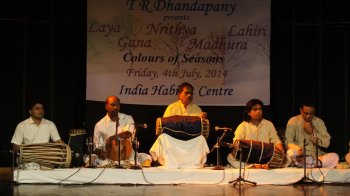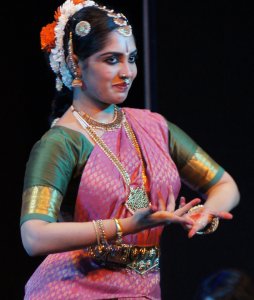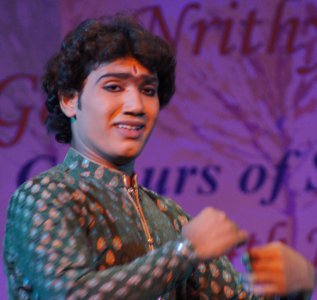
|   |

|   |
Raining taal - Shveta Arora e-mail: shwetananoop@gmail.com Photos: Anoop Arora August 16, 2014 On the 4th of July, ‘Laya Gana Nrithya Madhura Lahiri’ was held at IHC in Delhi. The concert is the brainchild of leading percussionist T.R. Dhandapany. A renowned exponent of Talavadhyam, he is perceived as the pioneer who brought percussion and percussion instruments to centre stage. Percussion is usually seen as an accompaniment, or secondary. In this concert, equal importance was given to vocals, both Hindustani and Carnatic, melodic instruments, percussion instruments and dance forms.  Dhandapany took his initial training in mridangam from Sikkil Natesa Iyer. Later, he specialized under the tutelage of Late Harihara Sharma and KM Vaidyanathan. He has been performing for the last five decades and has accompanied many top-ranking musicians. He started the talavadya programs in1980 to bring percussion instruments to the centre stage. In 1982, to ‘Laya Gana Madhura Lahiri’ he added music to make it more attractive to the audience. Since then, he has given more than 350 of these performances at various cultural events in India and abroad. In 2001, nrithya was added to the program and the title. This, he said, was done to give it a more holistic approach. The dance was added to give it a visual aspect on the request of European audiences. His son, who organizes the events, said that they thoughtfully incorporated the theme of the seasons to the choreography. He wanted to welcome the advent of monsoon by ending with a composition on the monsoon. He was accompanied by D. Kartik Narayanan on mridangam, R. Krishnan on morsing, P. V. Raghavanasimhan on ghatam, R. Ramkumar on pakhawaj, Suraj Nirwan on tabla, G. Navneeth on kanjira, Dr. S. Vasudevan on Carnatic vocal and nattuvangam, Sudhanshu Sharma on Hindustani vocals and parhant, D. Venkatasubramanian on violin and music composition, Gayathri Sharma on violin and vocals, Kiran Kumar on flute, Puraskar Nirwan on sitar. Featured were Bharatanatyam dancer Varsha Ramkumar and Kathak dancer Sunny Sisodia. It was a team of 15. 

The composition, the music and the choreography were based on a raga to depict the season. They started with winter depicted by raag Malkauns or Hindolam. The raga was chosen to show the calm and sombreness of winter. The composition was set to Sankirnajati Jampa talam, a cycle of 12 beats. The spring season was depicted by raag Basant. The composition was set to Chatusrajati Matya talam, a cycle of 10 beats. Raag Deepak is associated with summer. The composition was in raag Brindavani Sarang and set to Khandajati ata talam, a cycle of 14 beats. The rainy season was depicted using the Malhaar group of ragas. The composition was in Miya ki Malhar and set to Chatusra Triputa talam, a cycle of 8 beats. The percussion and the music set hearts racing, besides bringing out the mood of each season. Each performer exhibited his individual skills and then they all performed as a group to finally join in a crescendo. The piece for monsoon had excellent music, the sounds of the rumbling clouds, lightning and rain. While each musician was commendable, the mridangam and tabla player warrant a special mention. 

The dancers Varsha and Sunny presented some good nritya. Each season and its composition depicted the state of nature - the birds, the lotuses, the bees and the rivers, the romance between couples. There were some costume changes, a different colour for each season. Shveta Arora is a blogger based in Delhi. She writes about cultural events in the capital. |